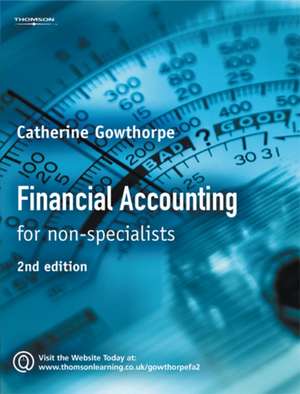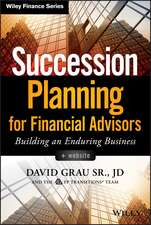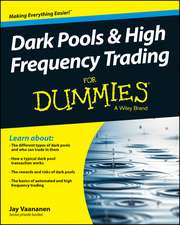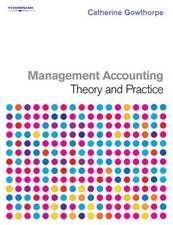Financial Accounting
Autor Catherine Gowthorpeen Limba Engleză Paperback – 5 iun 2005
Preț: 447.88 lei
Preț vechi: 581.50 lei
-23% Nou
Puncte Express: 672
Preț estimativ în valută:
85.70€ • 89.89$ • 71.35£
85.70€ • 89.89$ • 71.35£
Carte tipărită la comandă
Livrare economică 01-15 aprilie
Preluare comenzi: 021 569.72.76
Specificații
ISBN-13: 9781844802050
ISBN-10: 1844802051
Pagini: 400
Ilustrații: black & white illustrations
Dimensiuni: 190 x 246 x 17 mm
Greutate: 0.74 kg
Ediția:Revised
Editura: Cengage Learning
Locul publicării:United Kingdom
ISBN-10: 1844802051
Pagini: 400
Ilustrații: black & white illustrations
Dimensiuni: 190 x 246 x 17 mm
Greutate: 0.74 kg
Ediția:Revised
Editura: Cengage Learning
Locul publicării:United Kingdom
Notă biografică
Catherine Gowthorpe BA FCA is a chartered accountant with over twenty years experience as a lecturer and researcher in higher education, and is currently an examiner for one of the UK's leading professional accounting bodies'.
Cuprins
SECTION 1 ? Introduction and background to commercial business organisations CHAPTER 1 Introduction to business organisations and finance Forms of business organisation. Sole traders, limited companies and partnerships contrasted. Finance for business. Fundamentals of taxation. CHAPTER 2 Starting a business Financing the small business. The business plan. Why do businesses fail (and why do some of them succeed)? CHAPTER 3 The growing business Stages in business growth and expansion. Making money. Risk. CHAPTER 4 Large businesses Sources of finance for companies. The UK Stock Market. Organisation and operation of the London Stock Exchange. Flotation and other share issues. To list or not to list? The role of information in stock markets. CHAPTER 5 The role of accounting in business The need for accounting information. Users of accounting information. Characteristics of useful financial information. Financial accounting and management accounting. The role of the accountant in business organisations. Why do business managers have to understand accounting reports? SECTION 2 ? Financial accounting CHAPTER 6 The balance sheet Balance sheet basics. The accounting equation. Drawing up a balance sheet. More practice with balance sheets. CHAPTER 7 The profit and loss account Profit and loss. Categories of commercial activity. Profit and loss account for a sole trader. Movements in stock. Calculating cost of sales. Calculating net profit. What does the profit and loss account mean? Profit and loss accounting in a service business. Preparing the profit and loss account and balance sheet. CHAPTER 8 Adjustments to the profit and loss account and balance sheet ? part 1 Some further complexities in preparing the profit and loss account. Comprehensive example. Accounting conventions. Current asset adjustments. CHAPTER 9 Adjustment to the profit and loss account and balance sheet ? part 2 Depreciation and amortisation. Impact of depreciation on the accounts. Intangible assets and amortisation. Accounting for amortisation. Another method of depreciation. Sale of a fixed asset. Buying and selling assets during the year. CHAPTER 10 Cash flow The role of cash in business. Mismanagement of working capital. The distinction between profit and cash. Preparing a cash flow statement. Direct and indirect approaches to cash flow. The ?direct? method explained. Cash flow statements in an established business. The high profit/no cash paradox. CHAPTER 11 Financial reporting by limited companies Introduction to accounting by limited companies. Regulation of company accounting and other issues. Accounting for limited companies. Accounting for listed companies: additional requirements. CHAPTER 12 Analysing and understanding financial reports: Part 1 ? analysis of trends Usefulness of financial reports to various interest groups. Analytical techniques: changes in figures. Analytical techniques: changes in figures. Analytical techniques: horizontal and trend analysis. Analytical techniques: vertical analysis and common size analysis. Comparing businesses with each other. CHAPTER 13 Analysing and understanding financial reports: Part 2 ? analysis using accounting ratios. Financial ratio analysis techniques. Performance ratios. Liquidity ratios. Efficiency ratios. Investor ratios. Lending ratios. Index Answers to Self-test Questions Answers to Exercises
Recenzii
SECTION 1 ? Introduction and background to commercial business organisations CHAPTER 1 Introduction to business organisations and finance Forms of business organisation. Sole traders, limited companies and partnerships contrasted. Finance for business. Fundamentals of taxation. CHAPTER 2 Starting a business Financing the small business. The business plan. Why do businesses fail (and why do some of them succeed)? CHAPTER 3 The growing business Stages in business growth and expansion. Making money. Risk. CHAPTER 4 Large businesses Sources of finance for companies. The UK Stock Market. Organisation and operation of the London Stock Exchange. Flotation and other share issues. To list or not to list? The role of information in stock markets. CHAPTER 5 The role of accounting in business The need for accounting information. Users of accounting information. Characteristics of useful financial information. Financial accounting and management accounting. The role of the accountant in business organisations. Why do business managers have to understand accounting reports? SECTION 2 ? Financial accounting CHAPTER 6 The balance sheet Balance sheet basics. The accounting equation. Drawing up a balance sheet. More practice with balance sheets. CHAPTER 7 The profit and loss account Profit and loss. Categories of commercial activity. Profit and loss account for a sole trader. Movements in stock. Calculating cost of sales. Calculating net profit. What does the profit and loss account mean? Profit and loss accounting in a service business. Preparing the profit and loss account and balance sheet. CHAPTER 8 Adjustments to the profit and loss account and balance sheet ? part 1 Some further complexities in preparing the profit and loss account. Comprehensive example. Accounting conventions. Current asset adjustments. CHAPTER 9 Adjustment to the profit and loss account and balance sheet ? part 2 Depreciation and amortisation. Impact of depreciation on the accounts. Intangible assets and amortisation. Accounting for amortisation. Another method of depreciation. Sale of a fixed asset. Buying and selling assets during the year. CHAPTER 10 Cash flow The role of cash in business. Mismanagement of working capital. The distinction between profit and cash. Preparing a cash flow statement. Direct and indirect approaches to cash flow. The ?direct? method explained. Cash flow statements in an established business. The high profit/no cash paradox. CHAPTER 11 Financial reporting by limited companies Introduction to accounting by limited companies. Regulation of company accounting and other issues. Accounting for limited companies. Accounting for listed companies: additional requirements. CHAPTER 12 Analysing and understanding financial reports: Part 1 ? analysis of trends Usefulness of financial reports to various interest groups. Analytical techniques: changes in figures. Analytical techniques: changes in figures. Analytical techniques: horizontal and trend analysis. Analytical techniques: vertical analysis and common size analysis. Comparing businesses with each other. CHAPTER 13 Analysing and understanding financial reports: Part 2 ? analysis using accounting ratios. Financial ratio analysis techniques. Performance ratios. Liquidity ratios. Efficiency ratios. Investor ratios. Lending ratios. Index Answers to Self-test Questions Answers to Exercises












